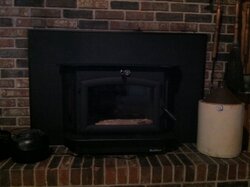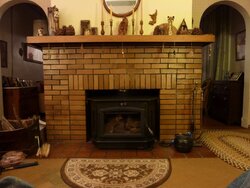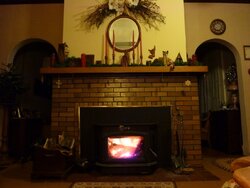We have a fireplace with internal chimney and love to burn but I knew it was inefficient and didn't make much if any heat. I grew up in a house with a woodstove and remember how much heat it blasted out. Then I also remembered hearing about wood burning firlace inserts. So one cold evening last year I started doing some internet searches and stumbled upon this site. I poured over it for months researching and reading reviews. I was amazed at how far wood stoves have come since the last time I used one. I was also amazed at the knowledge and expierence on this website.
Me and my wife visited a local fireplace and stove shop that is a buck dealer. We decided on the 91 and had it installed a few weeks ago with insulated liner. The day it was installed I built a smal fire in it even though it was 90+ outside. I just couldn't resist. I couldn't believe how fast it heated up and the amount of heat it put out. I never engaged the cat as it barely reached 600 degrees.
This week we had an evening that was in the low 60's and I lit the stove again and got the cat up to temp and engaged it. Holy cow is all I can say. With a few dry ugly cut offs and knots on a coal bed this thing was blasting heat. I can't wait for winter this year.
Just wanted to tell everyone thank you for sharing knowledge and I feel that if I run into any problems I think I can find the answers here.
Me and my wife visited a local fireplace and stove shop that is a buck dealer. We decided on the 91 and had it installed a few weeks ago with insulated liner. The day it was installed I built a smal fire in it even though it was 90+ outside. I just couldn't resist. I couldn't believe how fast it heated up and the amount of heat it put out. I never engaged the cat as it barely reached 600 degrees.
This week we had an evening that was in the low 60's and I lit the stove again and got the cat up to temp and engaged it. Holy cow is all I can say. With a few dry ugly cut offs and knots on a coal bed this thing was blasting heat. I can't wait for winter this year.
Just wanted to tell everyone thank you for sharing knowledge and I feel that if I run into any problems I think I can find the answers here.


 You'll like the 91, it can really toss some heat! These modern stoves like dry wood for quick start-up and the best heat output.. Hopefully you've got some dry wood to burn that has been split and stacked for a while? How fast it will dry depends on the specie; Oak is about the slowest to dry, and I like to have it in the stack, not split too big, for a couple years before I use it. But soft Maple here will be getting fairly dry in several summer months. I guess you've got a good bit of square footage to heat if you went with the big stove? Will heat flow well in your place, fairly open layout? We like pics, BTW.
You'll like the 91, it can really toss some heat! These modern stoves like dry wood for quick start-up and the best heat output.. Hopefully you've got some dry wood to burn that has been split and stacked for a while? How fast it will dry depends on the specie; Oak is about the slowest to dry, and I like to have it in the stack, not split too big, for a couple years before I use it. But soft Maple here will be getting fairly dry in several summer months. I guess you've got a good bit of square footage to heat if you went with the big stove? Will heat flow well in your place, fairly open layout? We like pics, BTW.  Read your manual a few times, there's good info in there. The 91 is at my MIL's house so I load twice a day. If it were at my house I could open the air a little at the end of the burn to keep stove temp up and make for quicker cat light-off on a fresh load. You can see the cat glow through the bypass rod hole but even when it isn't glowing, the cat probe will tell you if it's burning. When ramping up a cold stove, I give it just enough air to get some decent flame in the box (not a roaring fire) and then close the bypass when I've got 900 or better on the probe. I keep some flame going for a while after I close the bypass to make sure the cat is burning well before I cut the air back. Now, I've got the old Condar probe, not the new one with the two-tone silver/black dial, and the old one reads a little higher from what I hear. My probe would go high (1800+) if I got too much of the load burning at once, and I avoid that as much as possible. I make it sound more complicated than it really is and with a little experience you'll have the stove doing what you want in no time. Don't hesitate to ask any questions that may arise. Enjoy the heat!
Read your manual a few times, there's good info in there. The 91 is at my MIL's house so I load twice a day. If it were at my house I could open the air a little at the end of the burn to keep stove temp up and make for quicker cat light-off on a fresh load. You can see the cat glow through the bypass rod hole but even when it isn't glowing, the cat probe will tell you if it's burning. When ramping up a cold stove, I give it just enough air to get some decent flame in the box (not a roaring fire) and then close the bypass when I've got 900 or better on the probe. I keep some flame going for a while after I close the bypass to make sure the cat is burning well before I cut the air back. Now, I've got the old Condar probe, not the new one with the two-tone silver/black dial, and the old one reads a little higher from what I hear. My probe would go high (1800+) if I got too much of the load burning at once, and I avoid that as much as possible. I make it sound more complicated than it really is and with a little experience you'll have the stove doing what you want in no time. Don't hesitate to ask any questions that may arise. Enjoy the heat! 


